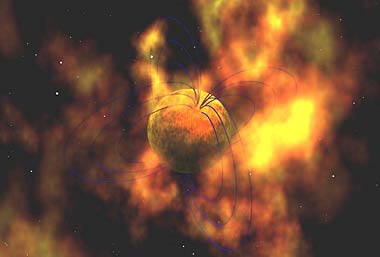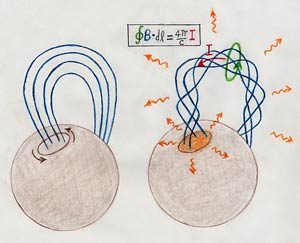UC Berkeley Press Release
 This depiction of a magnetar -- a spinning, highly magnetized neutron star -- shows the superstrong magnetic field lines (blue) and surrounding hot gas. According to one theory, these magnetic field lines periodically get twisted when the star's crust shifts. As the field lines untwist and reconnect they blast out a storm of particles that annihilate one another and produce a split-second flash of X-rays and gamma rays, which we see as soft gamma repeater flares like that observed Dec. 27, 2004. (Image courtesy Dr. Robert Mallozzi / University of Alabama in Huntsville / Marshall Space Flight Center) |
RHESSI satellite captures giant gamma-ray flare
BERKELEY – Astronomers around the world recorded late last year the brightest explosion ever of high-energy X-rays and gamma rays — a split-second flash from the other side of our galaxy that was strong enough to affect the Earth's atmosphere.
The flash, called a soft gamma repeater flare, reached Earth on Dec. 27 and was detected by at least 15 satellites and spacecraft between Earth and Saturn, swamping most of their detectors. Some of the best observations were recorded by the Reuven Ramaty High Energy Solar Spectroscopic Imager (RHESSI), a NASA/University of California, Berkeley, satellite launched in 2002 to study gamma-ray emissions from solar flares.
"It was the mother of all magnetic flares — a true monster," said Kevin Hurley, a research physicist at UC Berkeley's Space Sciences Laboratory who leads a major international team studying the event.
Thought to be a mighty cataclysm in a super-dense, highly magnetized star called a magnetar, it emitted as much energy in two-tenths of a second as the sun gives off in 250,000 years. Its intrinsic power was a thousand times greater than the power of all other stars in the galaxy put together, and ten thousand times brighter than the brightest supernova.
"This is a key event for understanding magnetars," said Robert C. Duncan of the University of Texas at Austin, who along with Christopher Thompson of the Canadian Institute of Theoretical Astrophysics, originally proposed and developed the magnetar theory. They both worked with Hurley's team to understand the immense power of the Dec. 27 flare, which exceeded all previous magnetar outbursts in our galaxy by more than 100. The team's observations and analysis are summarized in a paper that has been submitted for publication in the journal Nature.
"Soft gamma repeater" bursts — pinpoint flashes of highly energetic X-rays and low-energy (soft) gamma rays coming repeatedly from one place in the sky - were first noticed in 1979 and remained a mystery until theorists proposed in 1992 that they originate from magnetically powered neutron stars, or magnetars. Formed by the collapsing core of a star throwing off its outer layers in a supernova explosion, neutron stars are extremely dense, with a mass greater than the Sun packed into a ball about 10 miles across. Many neutron stars spin rapidly - some rotating a thousand times a second — and are called pulsars because they signal their presence by the emission of pulsed radio waves.
 This sketch shows how a seismic shift in the magnetar's crust can twist the strong magnetic field lines and generate currents (I) of charged particles that, through various processes, produce X-rays and gamma rays (squiggly orange arrows). (Image courtesy Robert Duncan, University of Texas, Austin) |
Magnetars are a special kind of neutron star. They are born rotating very quickly, which causes their magnetic fields to get amplified. But after a few thousand years, their intense magnetic field slows their spin to a more moderate period of one rotation every few seconds. The magnetic fields both inside and outside the star twist, however, and according to the theory, these intense fields can stress and move the crust much like shearing along the San Andreas Fault. These magnetic fields are a quadrillion — a million billion — times stronger than the field that deflects compass needles at the Earth's surface.
The shear moves the crust around along with the magnetic fields tied to the crust, generating twists in the magnetic field that can sometimes break and reconnect in a process that sends trapped positrons and electrons flying out from the star, annihilating each other in a gigantic explosion of hard gamma rays.
The flare observed Dec. 27 originated about 50,000 light years away in the constellation Sagittarius, which means that the magnetar sits directly opposite Earth in the disk of the Milky Way Galaxy.
As the radiation stormed through our solar system, it blitzed at least 15 spacecraft, knocking their instruments off-scale whether or not they were pointing in the magnetar's direction. Such energetic X-rays and gamma rays pass right through satellites, Hurley said, though the Earth's atmosphere absorbs them, both protecting us and preventing observation by surface telescopes. One Russian satellite, Coronas-F, detected gamma rays that had bounced off the moon.
"While all the real X- and gamma-ray detectors in space were swamped, the particle detectors on NASA's Wind spacecraft gave us our best reading on the distribution of energies of the gamma rays, and the particle detector on RHESSI told us the total energy content of the flare," said Steven Boggs, assistant professor of physics at UC Berkeley, who is leading the analysis of the Wind and RHESSI data.
"The initial spike killed us — completely saturated the RHESSI telescope — but after a half second, RHESSI recovered to observe the X-ray tail in its entirety," he added. "The RHESSI particle detector, however, with its minimal sensitivity to gamma-rays, has just become the smallest gamma-ray telescope ever in space. The fact that it is so small is why it was able to operate properly throughout the entire initial spike."
The flare also ripped atoms apart, ionizing them, in much of the Earth's ionosphere for five minutes, to a deeper level than even the biggest solar flares do, an effect noticed via its effect on long-wavelength radio communications.
Hurley and his team combined information from many spacecraft, including neutron and gamma-ray detectors aboard Mars Odyssey and many near-Earth satellites, in order to localize the giant flare to a spot well-known to astronomers: a magnetar known as SGR 1806-20. This position was accurately confirmed by radio astronomers at the Very Large Array in Socorro, N.M., who studied the fading radio afterglow of the event and obtained important information about the explosion.
The tremendous power of the event has suggested a novel solution to a long-standing mystery — the origins of a strange phenomenon known as "short-duration gamma ray bursts." Hundreds of brief, mysterious flashes of high-energy radiation from deepest space, lasting less than two seconds, have been measured and recorded over decades, but nobody knew what they were.
"It now seems likely that a sizeable fraction of these events, at least, are magnetar flares in distant galaxies," Hurley said.
The similarity between the Dec. 27 burst and these short-duration bursts lies in the brief spike of hard gamma rays that arrives first and carries almost all the energy. In the recent burst, for example, the hard spike lasted only two-tenths of a second. This was followed by a "tail" of X-rays that lasted over 6 minutes. As the tail faded, its brightness oscillated on a 7.56 second cycle, the known rotation period of the magnetar.
According to Duncan and Thompson's theory, the oscillating X-ray tail that followed was due to a residue of electrons, positrons and gamma-rays trapped in the magnetar's magnetic field. Such a hot "trapped fireball" shrinks and evaporates over minutes, as electrons and positrons annihilate. The measurements of Hurley's team corroborate this picture. The tail's brightness appears to oscillate because the fireball is stuck to the surface of the rotating star by the magnetic field, so it rotates with the star like a lighthouse beacon.
Hurley and his team argue that the hard initial spike of these giant flares is so bright that it can be detected from very far away, meaning that the flares we see are from other galaxies, though the soft X-ray tails are too faint to be seen.
"If a magnetar flares up in a distant galaxy within a hundred million light-years of Earth, we should be able to detect it, assuming that it is as bright as the December 27 event," Hurley said. "Since there are very many galaxies within this distance range, we should see these events frequently."
A test of this theory should come soon, because the recently launched Swift satellite carries sensitive gamma-ray detectors designed, in part, to unravel the short gamma-ray burst mystery. Launched in November 2004 and gathering data only since January, it is designed to automatically turn its X-ray telescope toward a burst in order to accurately pin down its position.
Hurley's team estimates that Swift will spot an abundance of magnetars lurking in other galaxies. In some cases, Swift's X-ray telescope may even catch the oscillating tail and measure the rotation period of the faraway star. In any case, Swift will probably localize some short bursts of gamma-rays to galaxies within about 100 million light-years of Earth, betraying their magnetar origins.
"Swift will open up a new field of astronomy: the study of extragalactic magnetars," said Duncan.
Co-authors with Hurley, Boggs, Duncan and Thompson were D. M. Smith of the UC Santa Cruz physics department, RHESSI and Wind principal investigator and Space Sciences Laboratory Director Robert Lin, and teams of U.S., Swiss, Russian and German scientists.

